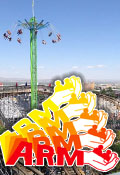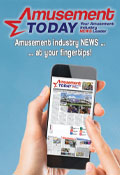Year-old projection mapping spectacular ‘Brilliant!’ a big draw
AT: Dean Lamanna
LAS VEGAS — A popular attraction preserving Sin City’s rich history of glitz, the Neon Museum has seen its attendance rise dramatically since the arrival of “Brilliant!” — a 360-degree audiovisual experience at the two-plus-acre repository of old signage located just north of downtown.

The spectacular nighttime show, which debuted in February 2018, utilizes projection mapping technology — a technique that creates augmented reality by aligning digital animation with physical objects — to reanimate 40 unrestored signs in the nonprofit museum. Incorporating archival footage from the Las Vegas News Bureau, the presentation transports guests back to the Vegas of yore as the iconic signs come to life accompanied by period music.
By the end of its fiscal year in mid-2018, the museum, boosted by the show, had welcomed a record 200,000 visitors — representing a 58 percent year-over-year attendance increase.
Rob McCoy, museum president and CEO, told Amusement Today that “Brilliant!” has brought needed glamour to the attraction’s North Gallery, or Neon Boneyard Park, where unrestored signs in the collection are more informally displayed.
“It is the perfect complement to the other side of our museum, where our interpreters give a one-hour historical guided tour of the main collection,” said McCoy. “We’ve combined our unique history with a bit of dazzle into one very special ‘edutainment’ presentation that appeals to everyone from art lovers to techno-geeks.”
Road to re-illumination
“Brilliant!” is the brainchild of Craig Winslow, a digital artist and experiential designer based in Portland, Ore. Elected by the computer software giant Adobe as one of the company’s 2016-17 creative residents, Winslow embarked on an artistic journey across the southwestern U.S. called “Light Capsules” that found him creating pop-up, one-night-only projection mapping shows that revived large ghost signs — faded, hand-painted advertising signs that can still be found on the sides of century-old brick buildings in some cities and towns.

The adventure, which took Winslow from Los Angeles to Austin, Texas, where Adobe scheduled him to speak at the annual multimedia conference and festival South by Southwest, made a fortuitous stop in Las Vegas in February 2017. Although the city, being relatively “young,” didn’t have any ghost signs to revive, Winslow was taken by the old signs he saw at the Neon Museum.
The artist emailed the facility, telling staff about his traveling project and how he wished to demonstrate the technology on its collection. “They were really confused at first, saying, ‘We don’t want you to mess up our signs,’” Winslow told AT. “And I kind of had to educate them on the concept and explain that it was non-damaging.”
Projection mapping was a sensible approach to relighting the signs, which in actuality would cost many millions to restore, he pointed out. “Even if you refurbish them, you lose their patina and wornness. With projection mapping, there’s just something kind of beautiful about showing the present and the past and the future all at once.”

After doing his customary historical research to determine the proper original look and context of the signs, the artist computer-designed his animations and then set up a generator and some projectors in the museum’s Neon Boneyard Park to show the staff, in a limited way, what he could do. Winslow said it opened a “magic time portal to the [artifacts’] former glory” in what essentially became another pop-up performance in his traveling series.
The next day, he received an excited message from museum CEO McCoy: “Our whole organization is buzzing about this. We have to make this permanent. What will that take?”
Nine months of hard, painstakingly detailed work, it would turn out.
“What was really exciting working with the Neon Museum was that it wasn’t just one sign at a time that I would bring to life, but about 30 or 40 signs surrounding you completely,” Winslow said. “People don’t typically do this complex of an installation with mapping because it’s hard to keep the [projection] alignment precise. If the projected light doesn’t hit the bulbs and neon tubes in the signs perfectly, they don’t illuminate perfectly.”
That was just one of many challenges facing the artist when he undertook the project last May. Creating an intimate, immersive, theater-in-the-round-style experience in the otherwise exposed-to-the-elements, utility-free lot required careful planning along with a vision. And, while several signs needed some minor repositioning for optimal projection, a major rearrangement of the weathered, fragile, super-heavy structures was out of the question.

Still, Winslow scored when the museum allowed an addition to the existing Neon Boneyard Park display: four massive capital letters forming the word “STAR” from the 1958-built Stardust Hotel & Casino, which was demolished in 2007.
“They have a huge, previously unseen collection in storage because they just don’t have the space,” he said. “The letters became a really nice canvas to project historical content into.”
Installing “Brilliant!” involved building two enclosed 20-foot-tall, climate-controlled towers in the center of the space to hold eight projectors, various audiovisual controls and other needed electronics. The artist worked with regional institution YESCO (a.k.a. Young Electric Sign Co.) on the structures and the needed underground service lines.
“I loved having YESCO involved because, historically, they’re actually the ones who built all these signs back in the day,” he said. “I gave them sort of a rough design of the towers and they handled the engineering. It was a big technical feat.”
All that digital dazzle
For Winslow, a Maine native who graduated from Vermont’s Champlain College and did brand-focused work for a design studio before striking out on his own, computer-rendering the visual elements of “Brilliant!” was the biggest — and most creative — task.

The artist used a relatively new mapping process called structured light scanning that projects a known pattern, such as grids or horizontal bars, onto a scene. The deformation that results when the patterns strike surfaces within the scene, such as bulbs, bent metal and broken neon tubes, allows for the precise calculation of depth and other topographical information used to shape the animation.
“When I did the original Neon Museum pop-up demonstration, I took photo references and animated over them, and then warped the animations into a final place — which is the usual projection mapping workflow,” he explained, noting that he stepped-up the preparation and previsualization of the permanent installation with a combination of photography and drone video, enabling 3D computer modeling. “The tricky thing with ‘Brilliant!’ was that we have such a complex canvas of bulbs and neon in the Boneyard, and there’s such a depth to it. It’s not just like flat surfaces.”
Through the deployment of Adobe Illustrator and other software programs, Winslow achieved authentic-looking neon tube lighting and flickering bulb effects that, along with archival video compositions, comprise the 30-minute presentation. The visuals were edited and time code-synched to vintage tunes, the selection of which was a project unto itself.

Winslow chose songs that evoked nostalgia and created narrative flow, consulting with McCoy and the museum staff to make sure he was including a range of music styles that represented the city’s midcentury era and evolution. Among the tunes were are The Chordettes’ “Mister Sandman,” Liberace’s “Strangers in the Night” and Elvis Presley’s “Viva Las Vegas.” Frank Sinatra’s “Luck Be a Lady” was a shoo-in, as the collection prominently features a sign from the Lady Luck Casino Hotel (1964-2006). The music track is delivered via 24 weatherproof, discreetly placed surround-sound speakers.
Stoking the public’s curiosity in the city’s history, according to the artist, was a major goal of the project, as was the creation of a shared augmented reality experience free of headsets or other gear.
“We wanted to make it not just a light show, but have something that was meaningful and educational,” he said. “You don’t have to wear anything, you don’t have to be told how it works. You just have to experience it. Hopefully, by the end of the show, you’re saying to the person next to you, ‘I remember the Binion’s Gambling Hall horseshoe sign!’ And you’re making memories with others right there.”
The response to “Brilliant!,” meanwhile, has blown Winslow away. “Seeing people dancing and reacting emotionally to it — that we’ve struck a chord — has been really satisfying.”
•neonmuseum.org
This article appears in the MARCH 2019 issue of Amusement Today.
Get all the industry news delivered to your door!
SUBSCRIBE TO AMUSEMENT TODAY
or download our FREE app to view on your mobile device!















